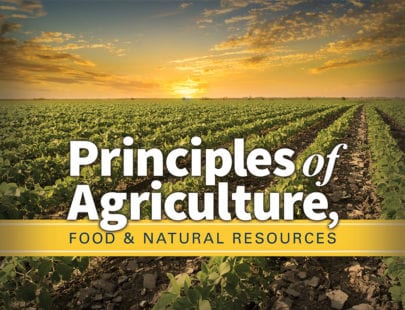
Agriscience 2b: Sustaining Human Life
Are you ready to embark on a botanical adventure? From home gardens to farms, dive into the world of plants and discover how to keep your plants thriving! This course provides an overview of the principles of landscape design, including the tools that help with planning and application to residential projects. Learn how to transplant and propagate, manage pests and diseases, and keep plants healthy through the proper use of pruning and weeding. Explore horticulture’s impact on the environment and the role that you play. This course is your ticket to a greener and more vibrant world.
Units at a Glance
Unit 1: Landscape Design
If you’ve ever admired a beautifully landscaped yard or garden and wondered how it all came together, then this unit is the one for you! Many techniques and design principles are used to enhance the aesthetics and mood that a landscape can provide. You might also be surprised to learn that you can take some simple steps to help create a space that is beautiful and functional yet eco-friendly because it uses minimal resources. Let’s dive into all things related to landscape design!
What will you learn in this unit?
After studying this unit, you will be able to:
- Compare and contrast landscape design elements
- Identify landscape design principles
- Explore steps to draw or design a landscape plan
- Discuss the principles of Florida-Friendly Landscaping (FFL)
Unit 2: Classifying Indoor and Outdoor Plants
Have you ever wondered why someone might call a plant a name that’s different than the one you know? For example, imagine that you’ve just purchased a great-looking snake plant. A dinner guest compliments the unique coloring of your amazing mother-in-law’s tongue. Then, a neighbor pops over and comments on all the new growth on your Saint George’s sword. Wait—what? Is that plant really known by all those different names? Yep. They’re all names for Dracaena trifasciata. It’s not uncommon for plants to have lots of different names. That’s why plant classification and plant taxonomy are so important! If you are working on a landscape project or selecting plants for your home interior or yard, knowing how plants are classified ensures that you get what you want. Let’s check out some of the ways that plants are organized and what they need to thrive in your space and enhance your life!
What will you learn in this unit?
After studying this unit, you will be able to:
- Classify plants based on their life cycles
- Distinguish common indoor plants
- Analyze the needs of indoor plants and assess their benefits
- Differentiate between common outdoor landscape plants
Unit 3: Soil Science
When you hear the word “soil,” do you immediately think of dirt? Whether you realize it yet or not, the scope of what soil is extends far beyond that four-letter word. Soil is a resource that is vital not only to food production but also to the environmental health of our local and global communities as it has life-giving features that help to sustain our existence on Earth as we know it. Soil is actually considered a renewable resource; however, the process of soil development is so slow that it’s essential to preserve what we already have through conservation efforts and best management practices. Let’s check out some of the facilities and systems in which soil and even soil alternatives can be used for successful plant production.
What will you learn in this unit?
After studying this unit, you will be able to:
- Identify plant growing facilities and container types
- Describe how soils are classified
- Investigate how soil quality is determined and tested
Compare and contrast soil alternatives
Unit 4: Fertilizers
What kind of fertilizer do I need for my garden? Is it different than what I need to apply to my lawn? Do I need to know any special steps before I use fertilizer either at home or on the job? If you have asked yourself any of these questions, then this is the right unit for you to explore. There are so many options and methods for applying fertilizer to plants that the choices can seem overwhelming. However, if you follow the instructions on the fertilizer’s label and have the right tools, you can manage plant nutrients and help keep your houseplants and lawns looking nice year-round!
What will you learn in this unit?
After studying this unit, you will be able to:
- Differentiate between types and kinds of fertilizers
- Apply best management practices for fertilizer application
- Interpret fertilizer needs based on the type of plant
- Describe application methods for fertilizers
Unit 5: Plant Diseases and Pests
The impacts of pests and diseases are felt by plants and their growers all around the world. Understanding how plant pathogens spread and the pests that often introduce them is the first step in learning how to combat the challenges that they present, whether in the home, in your garden, or in production. Regardless of your career goals, a solid understanding of the life cycles of insects, an in-depth knowledge of available controls for pests and pathogens, and a strong awareness of the best safety practices when applying these chemicals can serve you well throughout your lifetime.
What will you learn in this unit?
After studying this unit, you will be able to:
- Describe the most common plant pathogens
- Characterize the feeding habits and life cycles of pests
- Explain proper use and safety regarding chemical pesticides
- Discuss the steps to follow in an integrated pest management program
Unit 6: Environmental Impacts and Plants
Horticulture brings a number of benefits to the environment and the community, enhancing the beauty of an area and increasing the value of properties while helping prevent soil erosion, absorb pollutants, and provide wildlife habitats. To reap these benefits, however, responsible stewardship of land, fertilizers, and pesticides must be maintained by everyone from the large-scale producers all the way down to the home gardener. In this unit, we’ll explore how you can help play a role in utilizing sustainable horticulture practices in your home, community, and beyond.
What will you learn in this unit?
After studying this unit, you will be able to:
- Describe the importance of horticulture to the environment, including best practices for sustainability
- Explain the concept of nonpoint source pollution and the watershed environment
- Identify best management practices to reduce pollution and conserve water
- Evaluate land selection and conservation practices to maximize productivity and increase stewardship
Unit 7: Landscape Maintenance: Pruning and Weeding
Did you know that a well-maintained landscape can add as much as 14 percent of value to your home? Many homeowners make big investments in their general landscaping maintenance, lawn care, and upkeep. Regardless of the type of landscape for which you’re responsible, there are a variety of maintenance skills and tools that are useful for you to know, including those required for pruning and weeding. In addition, knowing which options for turfgrasses are available can help you determine which type is best suited to your needs.
What will you learn in this unit?
After studying this unit, you will be able to:
- Explain proper pruning techniques
- Categorize common Florida weeds and their control methods
- Differentiate between appropriate pruning and weeding tools
- Compare and contrast varieties of turfgrass
Unit 8: The Business of Horticulture
Offering flexible work hours is a great way to attract someone to a job. A study in 2021 revealed that over 50 percent of respondents felt that flexible working hours were the most important to them when considering job opportunities. If you’re looking for flexibility in your career, you can choose to seek employment that offers this, or you could start your own business! In this unit, we will explore the free-enterprise system. We will also discuss how to prepare for an interview, hire someone, interact with customers, and manage a retail business successfully.
What will you learn in this unit?
After studying this unit, you will be able to:
- Explore the concept of the free-market system
- Summarize how to prepare for an interview and what to look for when hiring someone
- Describe methods for improving client communication and expectations
- Differentiate the major areas of retail business, including profit, pricing, and sales techniques
Required Materials
Physical
- Digital camera
- Hand shovel/spade
- Measuring tool (tape measure, ruler)
- Spray bottle with water
Software
- Graphic design software
- Presentation software
- Word processing software
Optional
- Art supplies
- Audio recording device
- Spreadsheet software
- Video recording device



